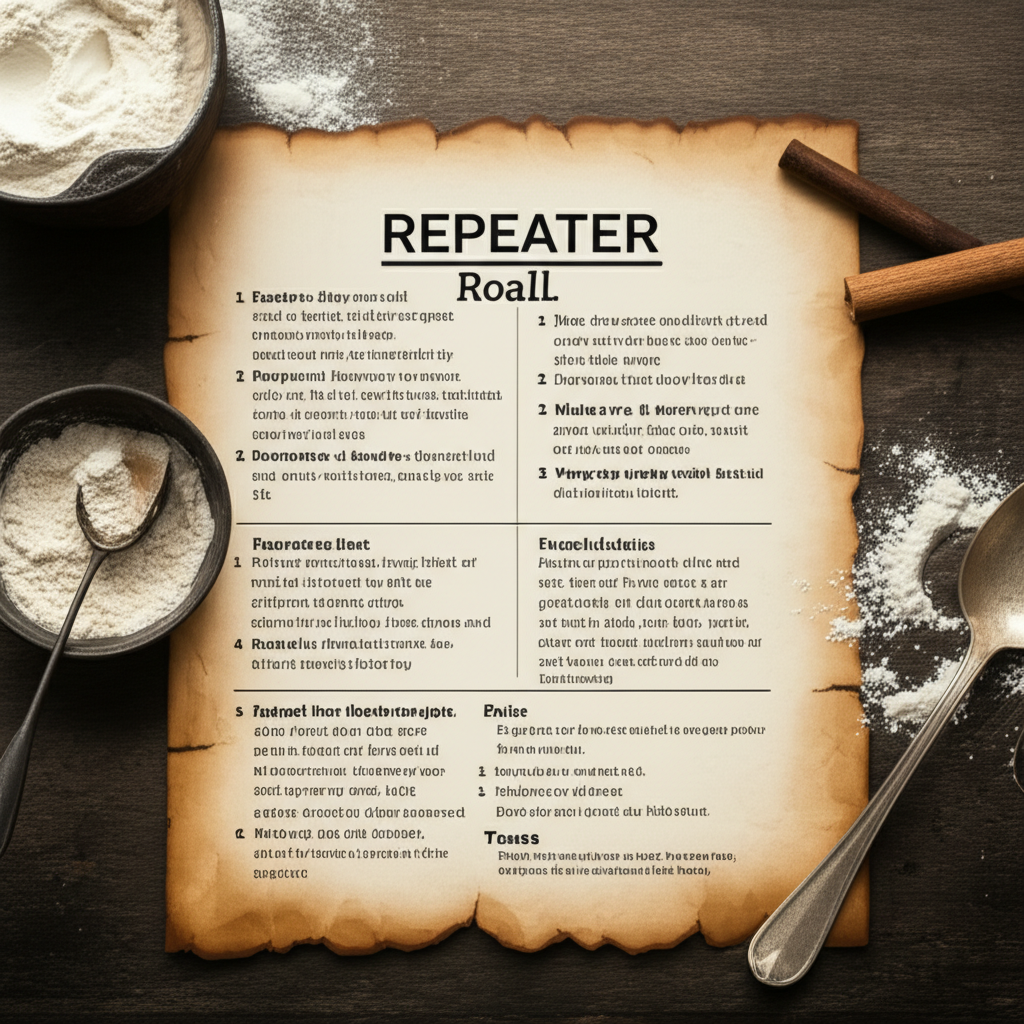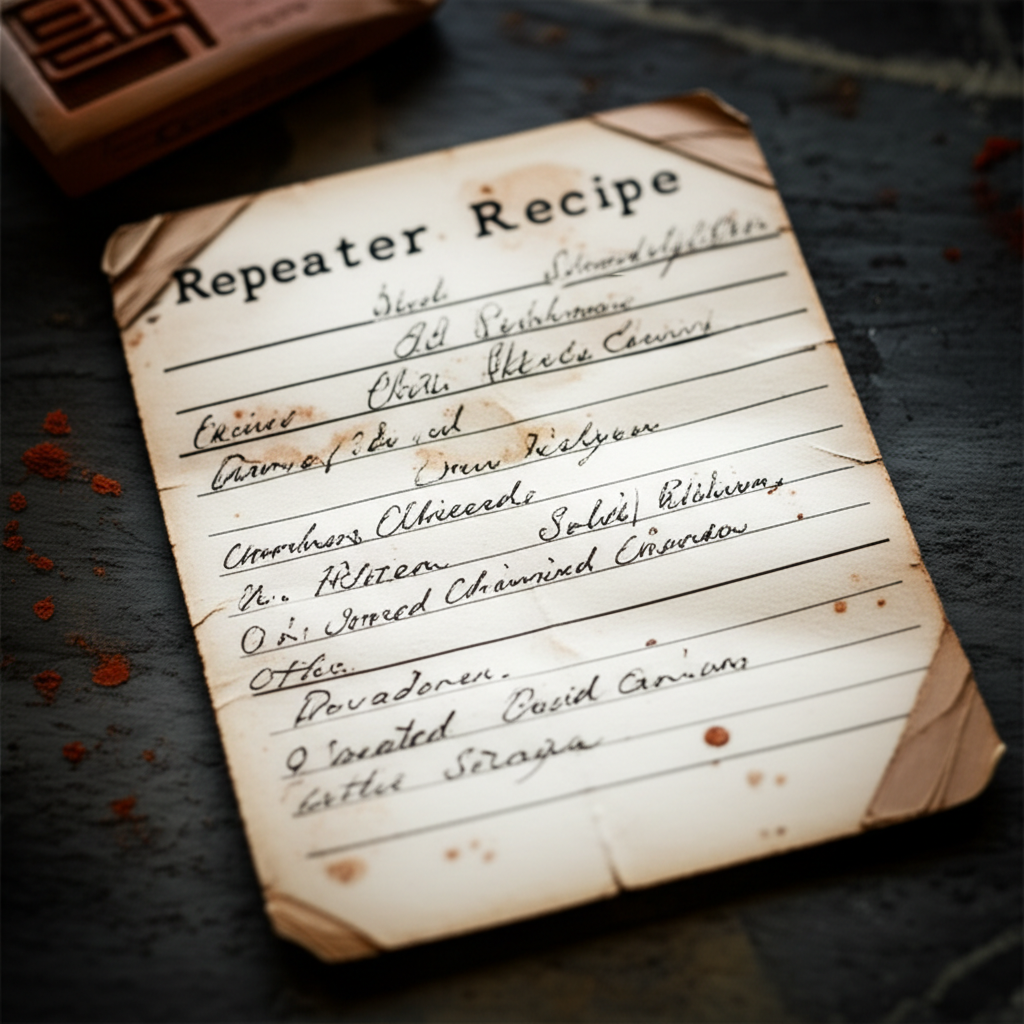repeater recipe
Repeater Recipe: A Comprehensive Guide
Quick Answer

Repeater recipe refers to the specific formula or instructions used to create repeater blocks, especially in Minecraft. These blocks automatically output a Redstone signal at adjustable intervals. A key attribute of a properly configured repeater is timing accuracy (measured in Redstone ticks), which is critical for complex circuitry. Correct repeater placement impacts your circuit’s overall function and timing.
Repeater Recipe Essentials

Understanding Repeaters in Minecraft
Repeaters are fundamental components in Redstone circuitry, offering controllable signal delay and acting as diode-like components to ensure one-way signal transmission. Their adjustable delay and unidirectional nature makes them indispensable for creating complex contraptions.
Why Timing Precision Matters
Precise timing is crucial for intricate Redstone mechanisms like clocks, piston doors, and automated farms. A repeater’s delay (attribute) directly affects (attribute) the timing of these circuits (entity). Delays range from 1 to 4 Redstone ticks, influencing the activation sequence and overall behavior of connected components. Miscalculations can lead to malfunctions and unexpected outcomes.
Crafting a Repeater
Crafting a repeater is straightforward. You’ll need the following readily available materials:
3 Stone: Easily obtained by mining stone with any pickaxe.
2 Redstone Torches: Crafted using a stick and a piece of Redstone dust.
1 Redstone Dust: Obtained from mining Redstone ore with an iron pickaxe or better.
Arrange these ingredients on your crafting table in a specific pattern: Redstone torches on the left and right in the center row, Redstone dust positioned in the middle square of the top row, and Stone completing the remaining squares.
Placing and Using Repeaters
Place your crafted repeater onto a solid block face. Right-click the repeater to cycle through its delay settings (1, 2, 3, or 4 Redstone ticks). A repeater locks its output signal when it receives a signal from its side. This is vital for creating circuits that need sequential activation and prevents signal cross-talk in complex circuits.
Repeater in Advanced Circuitry
Repeaters aren’t just simple delay devices; they play a crucial role in complex mechanisms. Understanding their properties is essential for designing effective Redstone contraptions.
Signal Locking and Its Applications
A repeater’s signal locking ability is crucial for circuits requiring sequential activation. For instance, in a piston door, staggered repeater delays prevent simultaneous piston activation, ensuring a smooth and correctly timed opening and closing sequence.
Example: Building a Simple Timer
1. Place two repeaters facing each other, leaving a one-block gap.
2. Set both repeaters on a delay of 4 ticks to create significant delays.
3. Power the first repeater using any redstone power source like a lever or button. Notice that the repeater in repeater can’t lock.
4. Observe the delay between the repeater’s activation and the change of repeater.
Comparison Table: Repeaters vs. Comparators
| Option | Key Attribute(s) | Best For | Caveat |
|———–|——————————-|——————————————-|————————————————-|
| Repeater | Adjustable delay, signal locking | Timing circuits, one-way signal transmission | Limited logical operations |
| Comparator | Signal strength comparison | Subtracting, comparing signal strengths | Requires understanding of signal strength mechanics |
Checklist for Using Repeaters
1. Gather materials: Ensure you have sufficient stone, Redstone torches, and Redstone dust.
2. Craft repeaters: Utilize the crafting table to create the required number of repeaters.
3. Plan your circuit: Sketch out your intended design to determine optimal repeater placement and delay settings.
4. Place repeaters: Position them strategically to control signal flow and timing between components.
5. Adjust repeater settings: Right-click the repeaters to set their delay, based on your circuit’s required timing.
6. Test and improve: Activate your circuit to verify correct functioning, then adjust repeaters as necessary.
Pro Tips for Working with Repeaters
Visualize Tick Delays: Imagine each tick as a very short pause; this helps predict signal propagation timing. (Entity: Tick, Attribute: Duration)
Leverage Signal Locking: Use this feature to create complex activation sequences and prevent unintentional feedback loops. (Entity: Repeater, Attribute: Signal Locking)
Shorten Circuits: Consider repeater placement to optimize signal paths and reduce overall circuit size. (Entity: Circuit, Attribute: Size)
Diode Functionality: Remember that repeaters only allow signals to travel in one direction. (Entity: Repeater, Attribute: Unidirectional signal flow)
Common Pitfalls and Fixes
Incorrect Delay: (Entity: Delay) Adjust the repeater’s tick setting to rectify timing issues. (Attribute: Adjustment)
Signal Blocking: (Entity: Block) Ensure no obstructions interfere with the repeater’s input and output. (Attribute: Removal of obstruction)
Burnout: (Entity: Redstone Torch) Replace the repeater with a working one and avoid short circuits. (Attribute: Replacement)
FAQs
What is the maximum delay a repeater can provide? A repeater offer delays of 1, 2, 3, or 4 Redstone ticks.
Can repeaters be used underwater? Yes, repeaters function underwater, allowing for complex circuits and contraptions in aquatic environments.
How does a repeater differ from a comparator? Repeaters offer simple, adjustable delays, whereas comparators have more nuanced functionality related to signal strength comparisons and subtraction that are integral to Redstone repeater recipes.
Do repeaters have different textures depending on the delay they are set on? No, repeaters offer different texture from the side where they are interacted.
Are repeaters essential for all Redstone builds? While not strictly required for every build, using the repeater in repeater recipes allows intricate timing mechanisms and control over directionality impossible to make without.
Can repeaters power other repeaters? Yes, repeaters can be chained together, extending the overall delay.
What happens when a repeater’s input is removed? The repeater’s output will turn off after its current timing cycle completes.
Key Takeaways
Repeaters precisely control signal delay and enforce one-way signal flow in Redstone circuits.
Accurate timing is crucial for complex Redstone mechanisms and relies heavily on the repeater recipe implemented.
Repeaters are crafted using readily available resources and offer four adjustable delay settings.
Signal locking and strategic implementation can prevent unwanted behavior in complex circuits.
Understanding common pitfalls helps avoid issues when working with repeaters.





